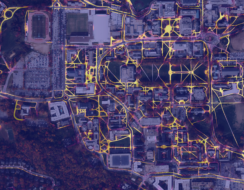When Nvidia CEO Jensen Huang, one of the most-watched figures in the world of technology, revealed an AI weather project involving his chipmaking behemoth and Spire, a space data company, people took notice.
$SPIR shot up 36%, and the company opportunistically raised $30M on the open market. The hype subsided, but the deal could be a model for space data companies looking to adopt advances in AI.
Payload spoke to Mike Eilts, a meteorologist and Spire’s general manager for weather and climate, about the deal and predicting weather from space.
This transcript has been edited for length and clarity.
How have you been experiencing the rise of transformer neural networks that are behind all this talk about AI?
There’s been a really weird last two years in weather…We went from ‘AI might be kind of cool in weather, we might be able to use it for some peripheral things.’Then about a year ago we’re saying, ‘Wow, this could actually work.’ And now we’re like, ‘Oh, crap, it might be better than what we’re doing already.’
A big part of Spire’s focus is data for weather prediction—how do the latest AI models impact your business?
A year ago, or even now, the company with the biggest supercomputer wins, basically. They can create the best forecast ’cause they can do more physics. And we run the global model today, physics-based, it costs us $600,000 a year or something—but [competitors can] buy $80M supercomputers—we’ll never keep up, right?
In the new world, we can run a global forecast out to 20 days on one GPU in 25 seconds, and it just changes the whole dynamic. You no longer need to buy big supercomputers. Instead, the companies with unique data sets win the game, right? And so we see it as a huge paradigm shift in the weather industry. So how do you differentiate? You have unique data.
We have unique data from our hundred satellites in space, and Nvidia saw that, we started talking about it, and they wanted us to be an early adopter of their Earth-2 platform.
You’re working on Earth-2, a digital twin or model of the planet, that Nvidia has built for climate modeling. What does that actually entail?
We’ve uploaded our data to their platform. They have done some amazing things to take some of the AI models that are out there and made it really easy for us to use. They’ve taken a [model from a] company called Pengu Weather, Google’s AI model, and there’s an Nvidia AI model. What they’re doing is making it really easy for us to test, experiment, learn, and run multi-hundreds of models at a time and look at ’em and figure out what we wanna do so that we can deliver the data directly to our customers.
How do you think about balancing the value of selling your data to AI partners, versus building your own models?
We want people to train their stuff, their analytics, on our data, because in the end, we can then sell our data back to them. Generically, a high level strategy is [to] sell the data, sell the analytics associated with the data, and eventually sell solutions. We’re not afraid to sell the data to people that want to train their solutions on it. But we also know that we over time are working more and more towards the solutions. You can’t build for every vertical, but you can find a lot of partners that do that. So we’re very much in a partner mode right now.
And what exactly does Spire’s weather data consist of?
We have a hundred satellites in space. We mainly listen to the GPS satellites, GNSS satellites. They’re constantly transmitting and when [that signal] comes through the top of the atmosphere, the beam is bent by temperature, humidity, so we can back out profiles of temperature, humidity, and pressure. As a meteorology industry we launched balloons, like 400 over the United States every day, twice a day, right? But [Spire] collects thousands of profiles all over the globe, over the oceans, where no other data is collected…We’re the only company that has that kind of information.




